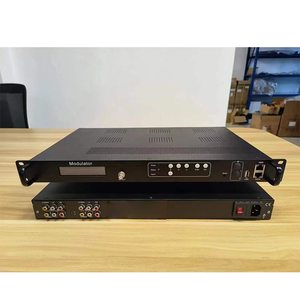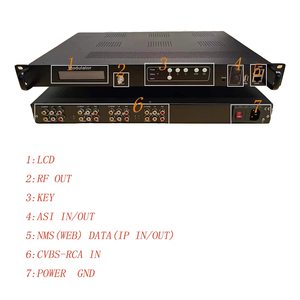(197 products available)





























































































































































An 8 AV encoder is a device that transforms multiple analog audio and video signals into a digital format. It enables the integration and transmission of analog multimedia content over network systems. Given its wide applications, the 8-channel encoder comes in different types depending on transmission medium and format.
Video and Audio Compatibility:
This type of 8 AV encoder is specifically designed to encode both audio and video signals. It allows users to simultaneously capture, compress, and transmit audio. This enables seamless integration of audio and video for applications like surveillance and broadcast.
Compression Standards:
Many 8-channel encoders use H.264 compression, which is a common standard for video compression. The H.264 AV encoder compresses the encoded video to optimize storage and bandwidth resource utilization without compromising quality. Some models support H.265 compression, which is the latest compression that offers better video quality at lower bitrates.
Transmission Medium:
Based on the transmission medium, there are two main types of 8-channel AV encoders: HDMI and IP. The encoder that uses an IP network as a transmission medium converts audio and video signals that can be encapsulated in IP packets. It can be transmitted over LAN or the internet. On the other hand, the encoder that uses HDMI encodes audio and video signals from HDMI sources. It compresses them for streaming or recording. Some encoders can take AV inputs from HDMI and also transmit the signal over AV over IP.
Streaming Protocols:
Depending on the application, some encoders support RTSP, RTMP, FTP, or HTTP for streaming. The encoder that supports RTMP can stream to many platforms like YouTube. RTSP streaming encoders can connect to IP cameras that are streaming over the RTSP protocol.
Resolution and Frame Rate:
Different AV encoders support different resolutions. Some only support up to 720p, while others can do up to 4K resolutions. The encoders also differ in frame rate support. Most encoders can support frame rates of up to 30fps, but some high-end models can do 60fps.
Connectivity and Ports:
Depending on the application, some encoders only have Ethernet ports for connecting to the LAN, while others can connect to a PC via USB. It can also connect to IP networks for streaming. The AV encoder with USB ports can also be used to connect storage devices like hard drives for recording
The function of the 8-channel AV encoder is to convert analog videos into a digital format that can be streamed or recorded. It does this by compressing the signal and packaging it according to specific transmission standards. Here are some features to be aware of:
Broadcasting and Media Production:
AV encoders are essential in the television and radio broadcasting industry. They digitize and encode video and audio from cameras and microphones for broadcasting live shows, news reports, sports events, and other programs on television channels. AV encoders also convert content from various sources into different formats for streaming on websites and mobile apps.
Live Streaming:
In recent years, live streaming has become very popular. AV encoders play a key role here too. They take the live video feed from cameras at concerts, sports games, conferences, and other events and encode it for streaming on platforms like YouTube Live, Facebook Live, Twitch, and more.
Video Conferencing:
AV encoders are also used in business video calls, online meetings, and video conferences. They ensure that the audio and video from webcams, microphones, and desktop screens are properly transmitted over the internet for clear communication between participants.
Surveillance Systems:
Security cameras capture footage of monitored areas. AV encoders convert this camera video into digital formats for storage on network servers or cloud-based storage solutions.
Sports Streaming:
Many sports leagues now provide streaming services to watch games online from home. AV encoders encode the video from cameras positioned around the field or court during the game for broadcasting on the league's website or app.
eLearning Platforms:
Educational websites offering video courses also utilize AV encoders. These encoders convert instructor-led class videos and presentations into streaming-friendly formats for online students to view lessons.
Medical Applications:
In hospitals, AV encoders can record surgeries, examinations, and other procedures. They digitize and store this important medical footage for future reference or training purposes.
When choosing an 8 AV encoder for purchase in bulk, it is important to consider the quality that will meet customers' expectations. This is the value of audio and video encoders based on multiple criteria, which include the following:
Q1 How many customers can be provided for 8 channels 8AV encoders?
A1: If the channels are switched one by one, there is no limit, but if they are used simultaneously, there are 8 at most.
Q2: What is the bitstream when transcoding the AV format to MPEG TS?
A2: The baud rate depends on the quality of the encoders and network conditions. The encoder can output different qualities, such as 2M, 2.5M, or 3.5M for 720P.
Q3 What is the delay for real-time streaming?
A3: The minimum delay is 0.5 seconds, and the maximum is 30 seconds.
Q4 Can the encoder output multiple streams?
A4: Yes, it can provide different qualities, such as 2m, 2.5m, 3.5m for 720p.
Q5 What RTSP server can this 8-channel encoder work with?
A5: This encoder is compatible with various RTSP servers, including Wowza Streaming Engine, Adobe Media Server, Red5, Nginx RTMP, and many others.